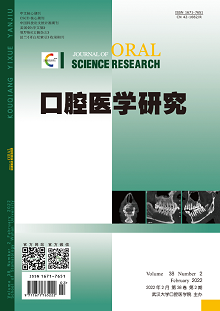|
|
CBCT Retrospective Study on Proportion of Displaced Root Fractures after Root Canal Therapy from 2014 to 2019
HAO Yanqing, TANG Rong, WANG Jinmeng, LIN Zitong
2022, 38(2):
181-185.
DOI: 10.13701/j.cnki.kqyxyj.2022.02.017
Objective: To conduct a retrospective study on the proportion of endodontically treated displaced root fracture teeth in all root fracture teeth based on oral and maxillofacial cone beam computed tomography (CBCT) from 2014 to 2019. Methods: The CBCT images in our hospital from 2014 to 2019 were screened. 1230 patients with 1262 root fractured teeth were enrolled in this study. The age, gender, medical history of root canal therapy, and tooth position was recorded. They were divided into two types: endodontically treated displaced root fracture (ETDRF) and non-endodontically treated displaced root fracture (NETDRF). The proportion of ETDRF and NETDRF in the total number of root fracture teeth was statistically analyzed, and the age, gender, tooth position, and type of root fractures of two groups were statistically analyzed. Results: Compared with 2014-2016, the proportion of ETDRF in total root fracture from 2017 to 2019 significant increased, and there were significant differences between 2014 and 2017, 2018 and 2019 (P<0.05). The average age of ETDRF patients was (56.2±13.4) years old, and NETDRF patients was (56.8±11.4) years old. There were no significant differences between two groups in different years (P=0.372 and P=0.273). The proportion of ETDRF teeth in female root fracture teeth significantly increased in 2017-2019 than that in 2014-2016, and there was a significant difference between 2014 and 2017 (P<0.001). Compared with 2014-2016, the proportion of ETDRF premolars in total root fracture of premolars significantly increased in 2017-2019. The maxillary premolars were significantly different in 2014, 2015, 2016 and 2018 (P<0.05), and the mandibular premolars were significantly different in 2014, 2015, 2016 and 2017 (P<0.05). Vertical ETDRF significantly increased in 2017-2019 than in 2014-2016, while vertical NETDRF did not change obviously from 2014 to 2019. There were significant difference between 2014, 2015 with 2017, 2018, 2019, 2016 with 2017, 2019 (P<0.05). Conclusion: The proportion of ETDRF teeth in total root fractured teeth increased in 2017-2019 than in 2014-2016. ETDRF in female and maxillary and mandibular premolars increased significantly, and vertical ETDRF increased.
References |
Related Articles |
Metrics
|

